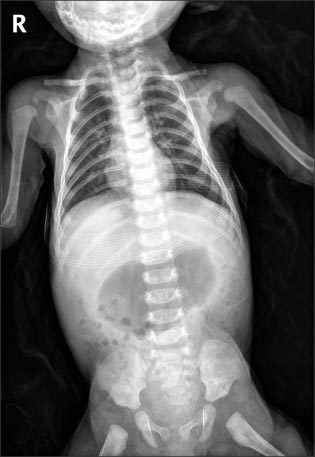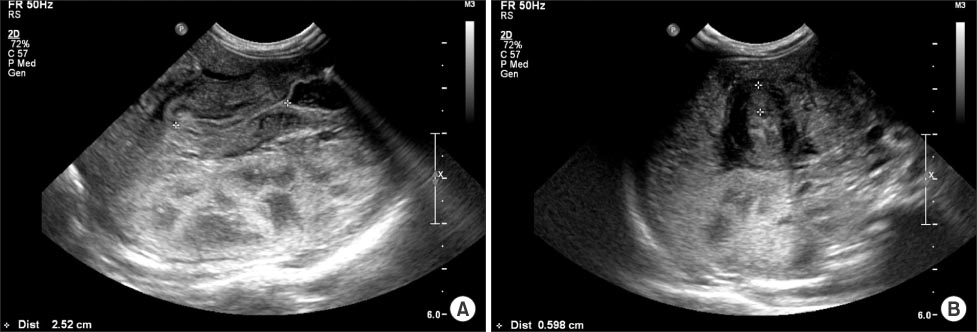J Korean Assoc Pediatr Surg.
2015 Dec;21(2):46-49. 10.13029/jkaps.2015.21.2.46.
A Natural Course of an Infantile Hypertrophic Pyloric Stenosis without Adequate Surgical Procedure
- Affiliations
-
- 1Department of Pediatrics, Gyengsang National University Hospital, Jinju, Korea. csassi@hanmail.net
- 2Department of Pediatric Surgery, Gyengsang National University Hospital, Jinju, Korea.
- 3Institute of Health Science, Gyengsang National University Hospital, Jinju, Korea.
- KMID: 2133791
- DOI: http://doi.org/10.13029/jkaps.2015.21.2.46
Abstract
- Infantile hypertrophic pyloric stenosis (IHPS) is one of the common surgical abdomen in infancy, characterized by progressive non-bilious vomiting. The etiology is unknown, but it likely develops after birth. The pylorus of the stomach becomes thick and triggers progressive vomiting. Abdominal ultrasonography (US) is widely used as a diagnostic tool. Currently, there is a rare IHPS patient with severe metabolic derangement because of general use of abdominal US and its accuracy. We experienced a natural course of a 62- day-old male infant with IHPS who was suffering from intermittent vomiting, loss of weight but had not been properly treated for 1 month. It is needed to make an effort to diagnose differentially in recurrent vomiting infant and check-up regularly, and also educate parents properly.
MeSH Terms
Figure
Reference
-
1. Whinney J, Paul SP, Candy DC. Clinical update: vomiting in infants. Community Pract. 2013; 86:44–47.2. Hernanz-Schulman M, Sells LL, Ambrosino MM, Heller RM, Stein SM, Neblett WW 3rd. Hypertrophic pyloric stenosis in the infant without a palpable olive: accuracy of sonographic diagnosis. Radiology. 1994; 193:771–776.3. Son SK, Park JH, Choi BH, Choi KH, Lee KH. A clinical analysis of neonatal surgical gastrointestinal diseases in Daegu/Busan area. Korean J Pediatr Gastroenterol Nutr. 2004; 7:179–185.4. Choi KJ. Infantile hypertrophic pyloric stenosis. Ewha Med J. 2012; 35:16–20.5. Park ES, Seo JH, Lim JY, Park CH, Woo HO, Youn HS. Hypoelectroly temia due to inadequate diet. Pediatr Nephrol. 2006; 21:430–432.6. Fustik S, Pop-Jordanova N, Slaveska N, Koceva S, Efremov G. Metabolic alkalosis with hypoelectrolytemia in infants with cystic fibrosis. Pediatr Int. 2002; 44:289–292.7. Mäkelä S, Kere J, Holmberg C, Höglund P. SLC26A3 mutations in congenital chloride diarrhea. Hum Mutat. 2002; 20:425–438.8. Kim YH, Jung MS, Byun SO. A clinical study of hypertrophic pyloric stenosis. J Korean Pediatr Soc. 2002; 45:1389–1396.9. Maclennan AC. Investigation in vomiting children. Semin Pediatr Surg. 2003; 12:220–228.10. Iqbal CW, Rivard DC, Mortellaro VE, Sharp SW, St Peter SD. Evaluation of ultrasonographic parameters in the diagnosis of pyloric stenosis relative to patient age and size. J Pediatr Surg. 2012; 47:1542–1547.11. Klaudia AH, Chris AL. Hypertrophic pyloric stenosis. In : Kliegman R, Nelson WE, St. Geme JW, editors. Nelson textbook of pediatrics. 19th ed. Philadelphia: Saunders;2011. p. 1274–1275.12. Hua L, Shi D, Bishop PR, Gosche J, May WL, Nowicki MJ. The role of UGT1A1*28 mutation in jaundiced infants with hypertrophic pyloric stenosis. Pediatr Res. 2005; 58:881–884.
- Full Text Links
- Actions
-
Cited
- CITED
-
- Close
- Share
- Similar articles
-
- Infantile Hypertrophic Pyloric Stenosis
- Clinical Experience of Circumumbilical Incision for Infantile Hypertrophic Pyloric Stenosis
- A ultrasonographic study of infantile hypertrophic pyloric stenosis
- A clinical analysis of the congenital hypertrophic pyloric stenosis according to the pyloric muscle thickness
- Infantile Hypertrophic Pyloric Stenosis (IHPS): Early postoperative changes of pylorus after pyloromyotomy using ultrasonogram in patients with IHPS



